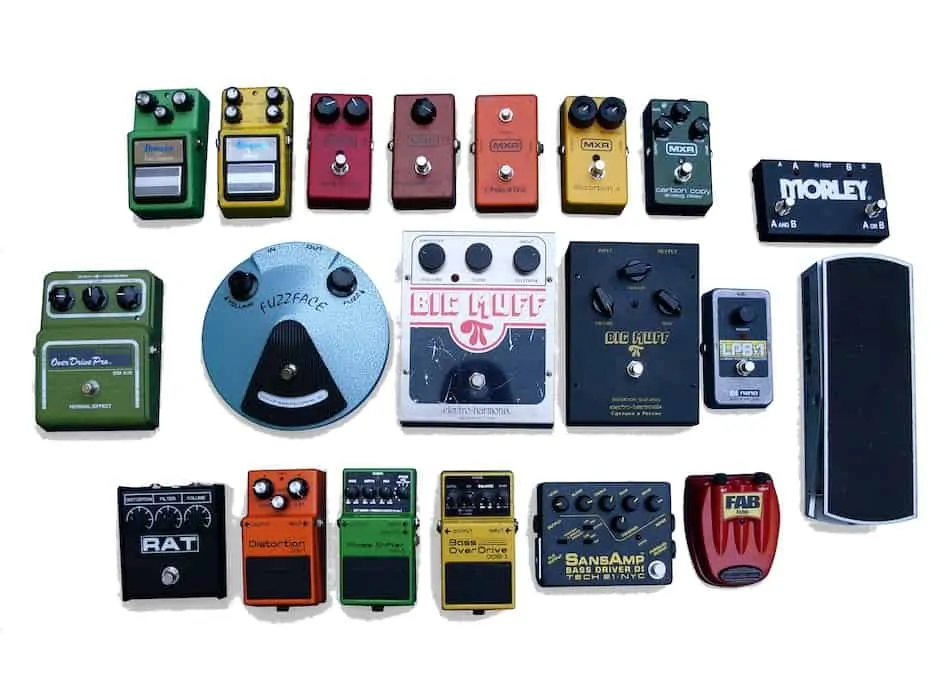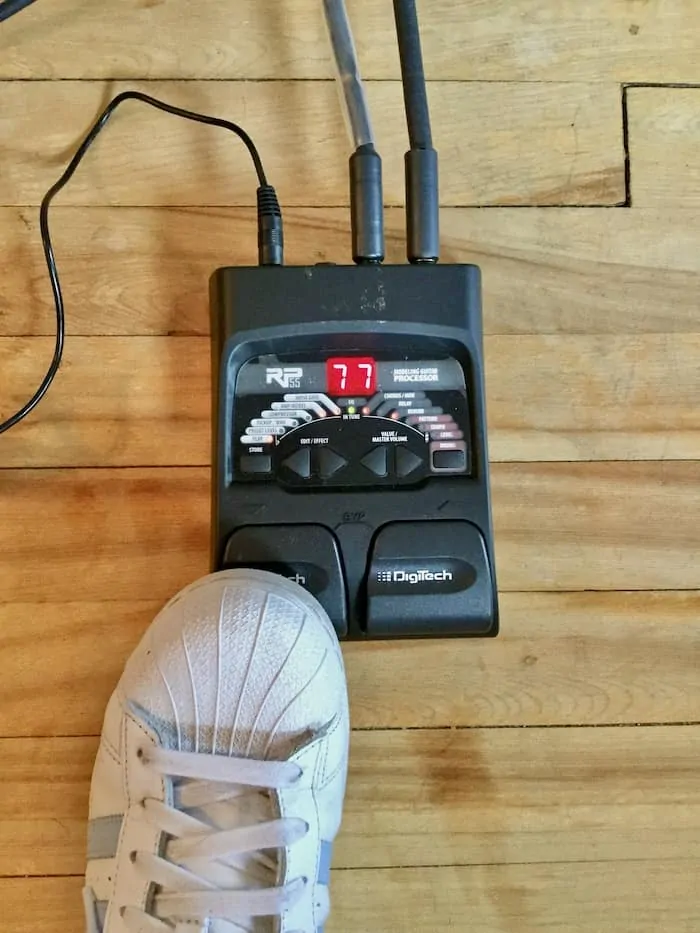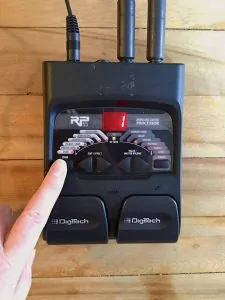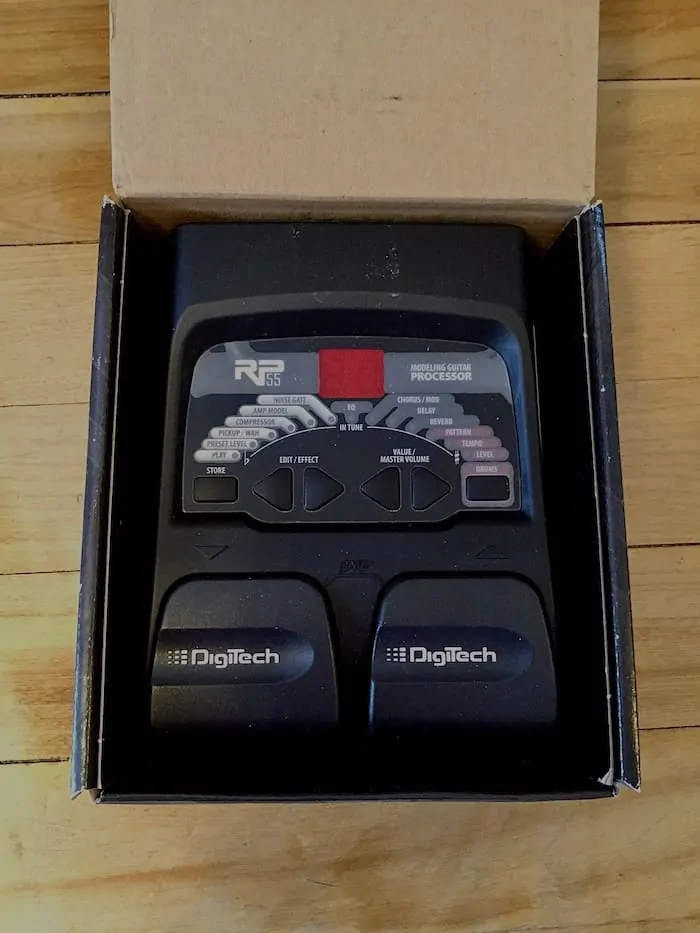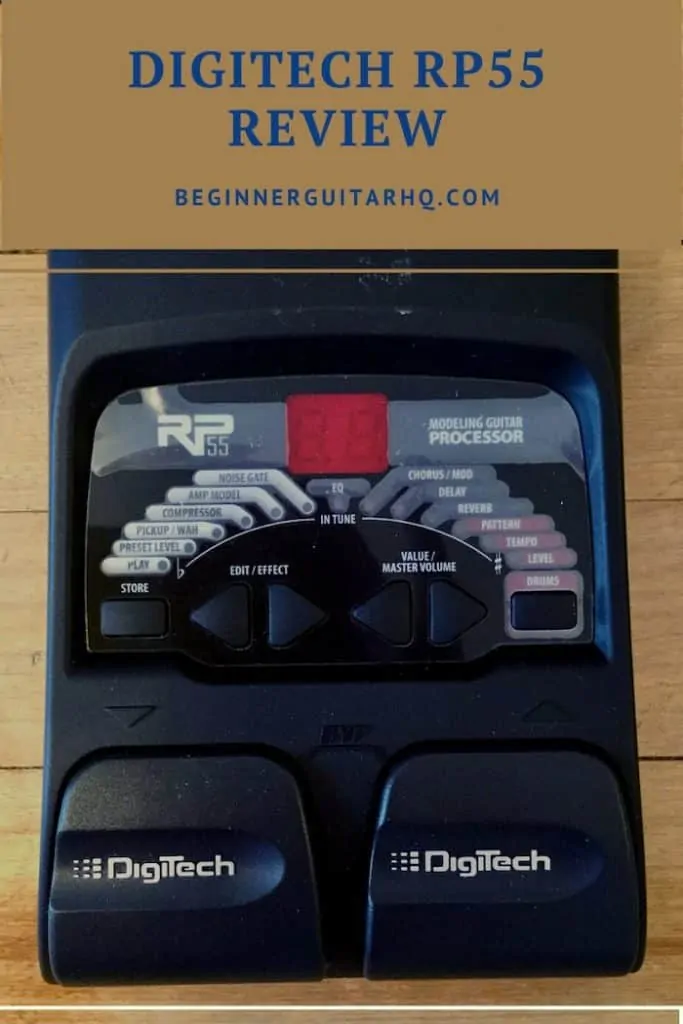Sooner or later, every electric guitarist faces the same dilemma. You’ve learned all your chords, mastered your pickups, and now you want to take your sound to the next level. Only with hundreds of effects pedals on the market, how do you know which ones are right for you? Do you go with a fuzz pedal or a distortion pedal? A volume pedal or a wah pedal?
With so many effects pedals available, it’s hard to decide which ones to buy, especially as a beginner (“Matt’s Pedal Collection” by Roadside Guitars / CC BY-SA 2.0).
Multi-effects pedals make the decision easier by offering all of these effects in one place. You can also combine different effects, extending the delay on your chorus or filtering your reverb through a boutique amp simulator. With so many options to customize your sound, it’s no wonder that their popularity has skyrocketed over the past decade, leading many guitarists to swap their pedal boards for a single pedal that does it all.
Like other multi-effects pedals, the DigiTech RP55 Modeling Guitar Processor offers an array of sonic possibilities, with 29 effects and 11 amp models. The DigiTech website claims that it combines an easy-to-use design with professional tone quality. And before they were discontinued, the new RP55s were some of the most budget-friendly pedals on the market. Pre-owned pedals are now even cheaper.
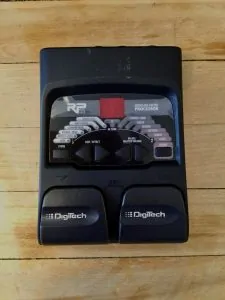
As a budding guitarist, I was overwhelmed by the diversity of effects pedals available to me. I eventually settled on the DigiTech RP55 because it was cheap and offered lots of effects to experiment with.
The DigiTech RP55 certainly looks good on paper. But does it actually live up to the hype? To answer this, let’s take a closer look at its set up, its design and most importantly, its sound.
Set up
The DigiTech RP55 has a basic set up that’s essentially the same as other effects pedals.
At the back of the pedal, you’ll find an input cable jack for your guitar and the output jack for your amp or headphones right beside it. Beside this is a control-in jack for adding an optional TS expression pedal for the wah, whammy and volume effects (this pedal isn’t included with the RP55).
All four jacks are clearly labelled on the back panel of the DigiTech RP55.
At the far right, you’ll find another jack to connect to a 9V DC adapter. Or, you can insert 6 AA batteries into the compartment at the bottom of the pedal. These will last for up to 10 hours of playing.
One thing that I like about the RP55 is that there’s no power switch. Once you’ve plugged in your cables, you’re all set to start exploring different tones.
Design
With so many buttons and LEDs, the Digitech RP55 may seem intimidating at first. But once you get used to it, it’s easy to adjust your presets, turn on the built-in tuner, or switch between 30 drum machine patterns (which you can activate through the drums button on the right side of the pedal).
The most important controls are the two foot switches at the bottom of the pedal. They’re small with a sensitive touch, so a light toe tap is all you need to make them work. Tapping the right switch scrolls forward through the list of presets and tapping the left switch scrolls backward. Pressing and holding both switches launches tuner mode, while tapping both switches launches bypass mode. Although this mode isn’t true bypass, your tone and volume will only be slightly distorted compared to the clean sound of plugging your guitar directly into your amp.
Thankfully, you don’t need much foot pressure to scroll between presets.
At the top of the pedal is a display screen, which shows a two-digit preset number in play mode (the default mode), the settings for each effect in edit mode, or the letters “tu” in tuning mode.
Below this is an arc of LED lights. In play mode, it highlights the effects that are included in each preset. For example, in the “Stacked” setting (#1 user preset/#41 factory preset), delay is highlighted, while in “Octave Drive” (#4 user preset/ #44 factory preset), chorus/modulation and reverb are highlighted. Although the amp model, noise gate and equalizer options are always on in play mode, you can still modify them by selecting their LEDs in edit mode.
In tuner mode, the LEDs become an oversized chromatic tuner, showing you how far your strings are out of tune. Finally, in drum mode, they highlight the pattern, tempo or volume of your beat.
Below the LEDs and above the foot switches are two sets of buttons shaped like arrows. On the left side is the effect/edit buttons, which you use to select the LEDs corresponding to each effect. You can adjust the type and/or intensity of the effect with the value buttons on the right side of the pedal. Once you’re happy with your new presets, save them by pressing the store button beside the effect/edit buttons.

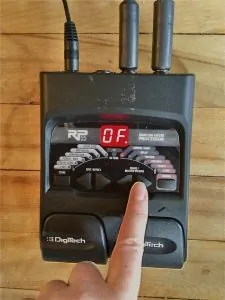
The controls on the DigiTech RP55 are easy to navigate in edit mode, whether you’re selecting effects, adjusting your values, or storing your modified user presets.
You can also use the value buttons to adjust your volume in play mode, change your key in tuning mode or scroll between the values in drum mode.
If you’re connecting a mixer or headphones to your pedal, you can also enable cabinet modeling to optimize the sound of each amp model. To do this, press and hold the drums button until the display reads CAb inEt On. Then, use your value buttons to select your amp model and corresponding cabinet (see the “Sound” section for the complete list).
Although I like the straightforward layout of the controls, I’m not impressed with the body of the pedal itself. Unlike other brands, which are often made of metal, the DigiTech RP55 is made of plastic. As far as plastic goes, it feels sturdy enough. But I’m still cautious of how much pressure I apply whenever I play it.
Sound
According to the DigiTech website, the RP55 achieves its tone quality through an advanced AudioDNA DSP processing chip and a 24-bit A/D/A conversion. This analog-to-digital-to-analog conversion is supposed to minimize the frequency loss when your sound travels from your guitar to your amp. This way, it preserves the exact bass, mid and treble levels from each preset.
The DigiTech RP55 has 40 user presets, which you can edit, and 40 corresponding factory presets, which are unchangeable. Each one has a creative name. Some, like “Bad Dog” (user #21/factory #61) and “20 Fathoms” (user #26/factory #66), don’t give a clear idea of their tone until you test them. But most of them directly reference the effects that they combine, like “Campfire Tremolo” (15/55), “Fuzz Church” (7/47) and “Rotary Blues” (12/52).
Each of these presets can combine up to eight different effects. These include:
- Pickup/Wah: selects the thick tone of a humbucker pickup (HS), the bright tone of a single coil (SH), or the frequency boost of a wah effect (when you add an expression pedal).
- The three types of wah effects include the traditional Cry Baby (Cr), modern Boutique (bo) or wide frequency Full Range (Fr).
- Compressor: balances the intensity of your sound by controlling the sustain of your guitar signal. You can adjust it from 1 to 15.
- Amp/Cabinet modeling: selects between 11 amp models and 1 acoustic guitar (AC) option, with a gain adjustment from 1 to 9. Each amp is linked to one of three cabinets..
- Blackface (b): based on the ‘65 Fender Blackface Deluxe Reverb amp (Fender 2×12 Twin Reverb Cabinet)
- Boutique (o): based on the ‘01 Mesa/Boogie Mark II amp (Mesa/Boogie Vintage 30s Cabinet)
- Rectifier (r): ‘01 Mesa/Boogie Dual Rectifier amp (Mesa/Boogie Cabinet)
- Hot Rod (H): ‘96 Matchless HC-30 (Marshall 4×12 Straight with Celestion Cabinet)
- Classic Tweed (t): ‘57 Fender Tweed Deluxe (Fender Cabinet)
- British Combo (C): Vox ‘63 AC30 Top Boost (Fender Cabinet)
- Clean Tube (c): Digitech Clean amp (Marshall Cabinet)
- British Stack (S): ‘77 Marshall Master Volume (Marshall Cabinet)
- Crunch (U): Digitech Crunch amp (Mesa/Boogie Cabinet)
- High Gain Tube (G): ‘83 Marshall JCM900 (Marshall Cabinet)
- Fuzz (F): Digitech Fuzz amp (Marshall Cabinet)
- EQ (equalization): shapes the bass (b), mid (d) or treble (t) frequencies in your signal.
- 1-4 cuts the level.
- 5 is flat, with no cut or boost.
- 6-9 boosts the level.
- Noise gate: contains two options.
- Silencer Noise Gate (G1-9): reduces humming and other noise when you’re not playing.
- Auto Swell (S1-9): mimics a volume pedal with set attack times.
- Chorus/Mod(ulation): includes all of the effects that change the pitch, volume or strength of your guitar signal, from 1-9.
- Chorus (C): adds a short delay to your signal, while modulating in and out of tune. Then, it mixes with the original signal for a thick, harmonic sound.
- Flanger (F): like the chorus effect, but with a shorter, repeated modulating delay.
- Phaser (P): splits your signal to create a warm, twisting sound.
- Tremolo (t)): modulates your volume at an even rate.
- Panner (n): modulates your sound from left to right at an even rate.
- Vibrato (b): modulates the pitch of your signal at an even rate.
- Rotary speaker (r1-9): slightly alters your pitch as it mimics a spinning horn/woofer.
- AutoYa (A): combines the wah and flanger effects.
- Envelope filter (E1-9): a dynamic wah that changes tone, depending on how hard you strum or pick.
- Detune (d): copies your signal slightly out of tune, then mixes it with the original.
- Pitch shift (H): decreases or increases your pitch up to 12 semitones.
- Whammy: with the expression pedal, it can bend the pitch of your incoming signal (y1-4) or add a bendable harmony to the original signal (y5-9).
- Delay: delays your sound, creating an echo. It includes 3 types: digital (d), analog (A) or pingpong (P). Each type can be set at 5% (1,4,7), 25% (2,5,8) or 50% (3,6,9) feedback and levels 15 (1-3), 30 (4-6) or 50 (7-9).
- Reverb: mimics the sound of performing in a real acoustic space like a room (r), hall (H), arena (A), or church (C), or through systems like a plate (P) or spring (S). Again, you can set the values from 1-9.
As you play around with the presets, you’ll notice that most of the effects are instantly recognizable. Just like the name suggests, “Power Flange” (14/54) has an 80s hard rock feel, with heavy distortion and a modulating delay. Similarly, “Slap Rhythm” (25/65) delivers a bright, snappy tone with a slight delay.
This video showcases the versatile tones of the RP55
Yet, not all of the effects have the pro quality that DigiTech promises. While the compressor, delay, phaser, flanger and fuzz amp are surprisingly good for a pedal in this price range, the chorus sounds tinny. The tremolo, pitch shift and rotary speaker are also weaker compared to those on other multi-effects pedals.
Still, the DigiTech RP55 does deliver some unique tones that are tailor-made for genres ranging from blues to surf rock to heavy metal. The diversity of available sounds (almost) makes up for some of these lower quality effects.
Final thoughts
While it’s a great practice pedal for beginners on a budget, the DigiTech RP55 isn’t suitable for performing or recording.
When they were first released, multi-effects pedals had a bad rap for poor workmanship and poor designs. The DigiTech RP55’s plastic body and tinny chorus effects reflect these concerns. But the sheer range of effects outdo many other pedals in its price range, while the simple design makes it a decent option for beginner guitarists.
I would recommend this pedal to anyone who is comfortable with the basics and wants to experiment with different effects. Playing around with my own DigiTech RP55 helped me figure out which tones I prefer, so I could save up money to buy higher quality single-effects pedals.
While it works great as a practice pedal, I wouldn’t recommend the RP55 for performing or recording. Sound quality aside, it doesn’t have the right design for gigs or recording sessions. Without the list of presets on hand, it’s difficult to remember the numbers for each one. Plus, even if you know which presets you want, it takes time to scroll to the right one––especially while changing effects in the middle of the song.
This makes the process a lot more complicated than on the Zoom MS-70CDR, Zoom G3Xn or NUX MG-20, where you can directly control your delay or reverb values through dials on your pedal. Pedals like the NUX MG-20 also one-up the DigiTech models by offering a built-in expression pedal, making it much easier to test your wah and volume effects.
Still, the Digitech RP55 is a decent multi-effects pedal with some redeeming qualities. It may have all that you need if you want to try out a couple of effects and see where they take you. In this case, it’s worth a visit to your favorite used gear website to see if you can find one for sale.

